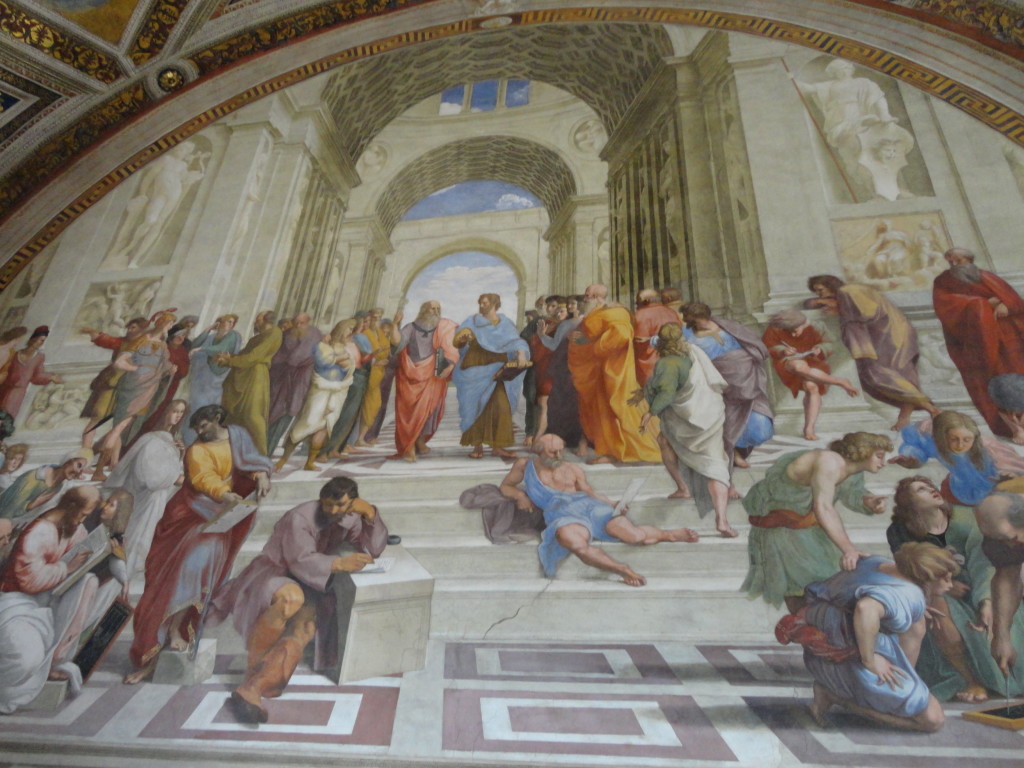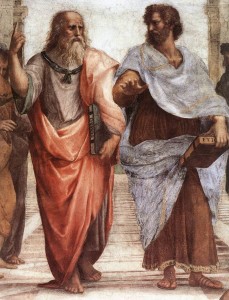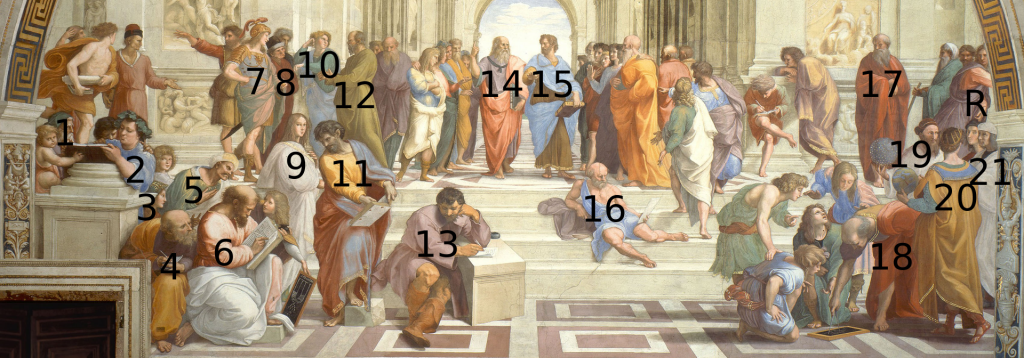Today* is the birthday of Raffaelo Sanzio da Urbino, or as we better know him, the painter Raphael. A contemporary of Michelangelo and Leonardo da Vinci, Raphael sometimes gets lost in their long shadows of memory. His art and capability, however, can arguably be said to outshine even those two masters.
I had the pleasure of seeing in person what is perhaps Raphael’s greatest work; it is certainly his best known. The School of Athens is a fresco decorating an entire wall in the Apostolic Palace in the Vatican.

It took two years to paint the fresco, all while Michelangelo was down the hall painting the famous ceiling of the Sistine Chapel. Raphael also painted many other walls in the Vatican, but The School of Athens was to be the apex of his career.
And he had fun with it. The School is one of four paintings on the walls of the palace depicting the four distinct branches of knowledge (Philosophy, Poetry [including music], Theology, and Law). The actual title given to the fresco is Causarum Cognitio, which translates roughly into “Seeking Knowledge of Causes.” While Raphael left no explanation for the figures, many have been identified as famous philosophers.

The only two undisputed figures are the two most obvious in the center of the crowd. Carrying their respective master treatises, Plato (Timaeus) on the left with his protégé Aristotle (Ethics) on the right.Their hand gestures are said to signify central aspects of their philosophies. Plato’s upward point at the vaulted ceiling contrasted with Aristotle’s more down-to-earth horizontal plane positioning. These may suggest a divergence of the two philosophical schools: the elder Plato arguing a sense of timeliness while the younger Aristotle focuses on the present and the physicality of life.
Plato vertically, upward along the picture-plane, into the beautiful vault above; Aristotle on the horizontal plane at right-angles to the picture-plane (hence in strong foreshortening), initiating a powerful flow of space toward viewers. It is popularly thought that their gestures indicate central aspects of their philosophies, for Plato, his Theory of Forms, and for Aristotle, his empiricist views, with an emphasis on concrete particulars. Many interpret the painting to show a divergence of the two philosophical schools. Plato argues a sense of timelessness whilst Aristotle looks into the physicality of life and the present realm.
Of course, since no one knows what Plato actually looked like, Raphael painted him to look a lot like a certain Leonardo da Vinci. Similarly, Aristotle is painted in the visage of sculptor Giuliano da Sangallo.
Beyond these two the identifications get dicier. The following comes from the Wiki page for the painting (click on the link to see the names):

Those that are more or less identified with certainty, in addition to Plato and Aristotle, are Socrates, Pythagoras, Euclid, Ptolemy, Zoroaster, Raphael (painters love to paint themselves into their art), Sodoma, and Diogenes. Others are more speculative. Since Raphael and Michelangelo were not particularly friendly rivals, the rather frumpy looking depiction of pre-Socrates Greek philosopher Heraclitus (#13 in photo above) just happens to look like Michelangelo.
By the way, the two big sculptures in the background are Apollo (left) and Athena (right).
A quick note about fresco. Derived from the Italian word for “fresh,” fresco is a technique of mural painting in which pigments are mixed in wet lime plaster and applied to walls and ceilings. As the plaster dries it becomes an integral part of the wall. It is notoriously difficult to work with, which is why they are so amazing to see today. Other great examples are down the hall in the Sistine Chapel.
Ironically, today is also the anniversary of Raphael’s death in 1520, apparently caused by a fever caught after a debaucherous night of excessive sex with his mistress. He was only 37. Raphael’s influence was so great that he was buried in Rome’s Pantheon.
*There is some question as to whether his birthday was April 6 or March 28 (Good Friday). Either way, he was born in Urbino, a small but “artistically significant” city in central Italy.
[Photo credits: 1st: Ru Sun; 2nd and 3rd: Wiki]
David J. Kent is the author of Tesla: The Wizard of Electricity (2013) and Edison: The Inventor of the Modern World (2016) (both Fall River Press). He has also written two e-books: Nikola Tesla: Renewable Energy Ahead of Its Time and Abraham Lincoln and Nikola Tesla: Connected by Fate. His next book is on Abraham Lincoln, due out in 2017.
Follow me by subscribing by email on the home page. And feel free to “Like” my Facebook author’s page and connect on LinkedIn. Share with your friends using the buttons below.











Really enjoy this fun and informative post! Looking forward to reading more…
Glad you liked it. It was a great trip!
I am finally able to comment! (Using a college computer today.)
A favorite artwork… and a most interesting piece of period art considering its location in the Stanza della Segnatura… in the library of the Papal Apartments. It seems to represent an extraordinary period of openness within the church, that a representation of classical knowledge would be placed within the center of the source of “Infallible” divine enlightenment.
My understanding was that the image of Heraclitus was added by Raphael after the completion of the original version. He is the “Buddhist” among the philosophers, “never stepping in the same stream twice,” the one amongst all who is still deriving the ever-changing truth of the moment (he alone is still writing). Michelangelo was supposedly a brooding personality — perhaps why Raphael used his likeness. Heraclitus also mirrors the prophet Isaiah on the Sistine ceiling, but Raphael reverses the gaze from up to down.
And then… opposite Heraclitus is Diogenes (16), possibly ridiculing the entire fresco. Ha! Artists of the time hid much meaning in their own interpretations. (And they exhibited great humor.)
BTW, Raphael hid his own likeness among the astronomers (around #21), probably depicting himself as Apelles (a great artist). He’d likely take tremendous joy in the legendary accounts of his own death.
Yay! Glad you could comment. And what a great comment at that. My understanding is the same as yours, that Heraclitus was added after he had completed the work. There is a great book called “Michelangelo and the Pope’s Ceiling” by Ross King that mentions it. The book obviously focuses on Michelangelo but talks quite a bit about Raphael and their rivalry.
I think Raphael is in there two or three times. It seems painters liked to squeeze themselves into their artwork whenever possible. Alas, the vanity. 🙂
True, but what a way to die.
Thanks! I guess a little of the attempts at enculturation during my youth managed to stick.
Raphael has always been one of my favorite artists from that era, although I think it worth mentioning that an instructor once told me that he found his work “garish” (this in response to my own expression of like for both “Saint George” and “Transfiguration”). However, I also very much liked “La Velata,” Rafael’s lesser known portrait specifically of Margherita Luti (who apparently modeled for many of Rafael’s works, including Transfiguration).
My understanding regarding Rafael’s death is that it was something of a legend concocted by Giorgio Vasari when writing his 1550 art history treatise, “Le Vite de’ più eccellenti pittori, scultori, e architettori da Cimabue insino a’ tempi nostri.” Raphael ended up entombed in the Pantheon beside his fiancé, Maria Dovisi (the daughter of a patron). Luti, however, did apparently retire to a convent shortly after Rafael’s death. Ah, love, or lust, or whatever… Makes for a very romantic story, anyway.
King’s book is now on my list…
I enjoy the intricacies of the paintings of that era. It sounds like you’ve spent some time studying the arts.
I don’t doubt that Raphael’s death story is more legend than reality, but a good story is allowed when it caps such a talented, though all too brief, career. I’ve never read Vasari but put it on my “to read” list a year or two ago (probably when reading one of Ross King’s books). I have, on the other hand, seen his tomb in the Pantheon a few times.
Major headache commenting from home!
I was “subjected” to a Liberal Arts education in my youth — hence science as a career.
Working from memory, however, there appears to be much I had either forgotten or just never knew (comme mon francais). I didn’t realize that Luti appears in The School of Athens (9). I am also in error that no one else is writing: Pythagorus (6) as well as whomever (4), and an unidentified person toward the upper right. And Raphael does indeed appear to be lurking here and there (3?)…
I’ve ended up reading several articles regarding the work this evening. Amazing. I should have paid better attention… Ah, but to be young. Margharita would have understood.
I also got a Liberal Arts education, though the science likely started the first time I watched Jacques Cousteau on TV. The art appreciation I apparently got early too, as I noted in a HWS piece called “An Odd Taste in Art for a Teen”: https://hotwhitesnow.wordpress.com/2014/11/03/an-odd-taste-in-art-for-a-teen/
There is so much going on in “The School” that you could probably spend ages reading about it. I hadn’t made the connection of La Fornarina (9) being Luti and had to look it up. Very cool. Definitely some insider information (and jokes) in the painting. 🙂